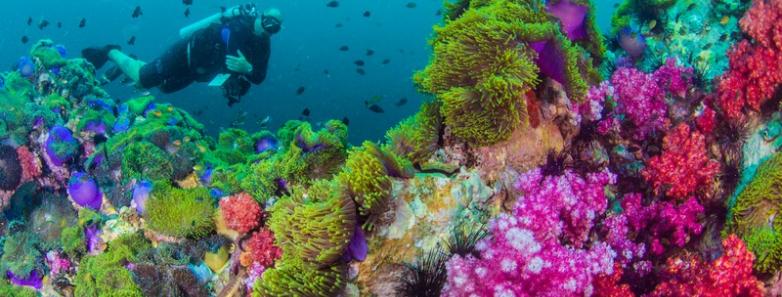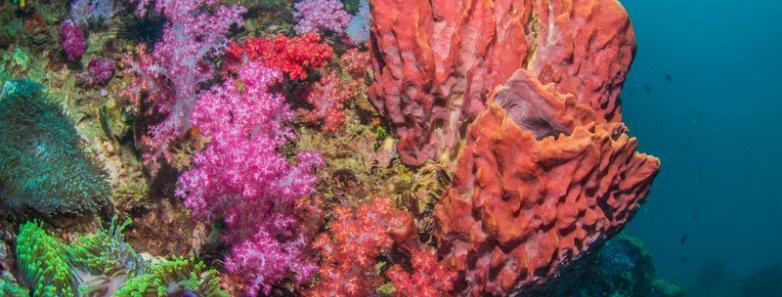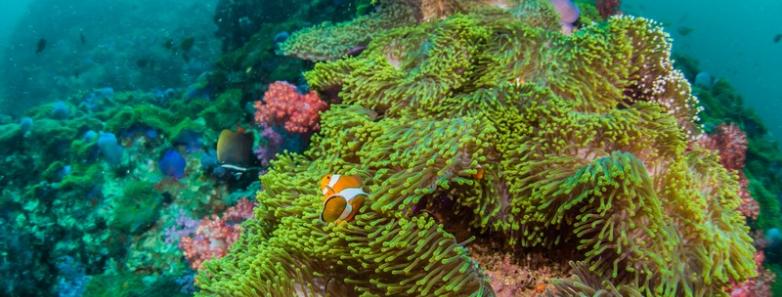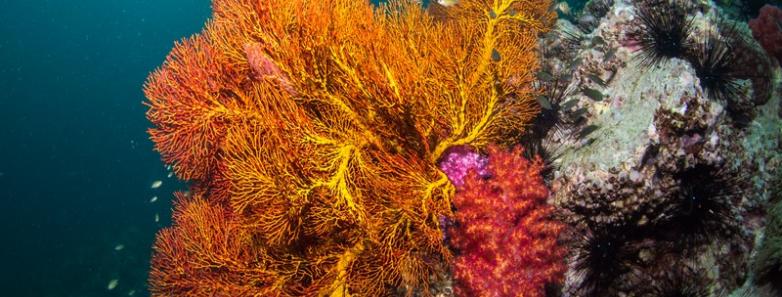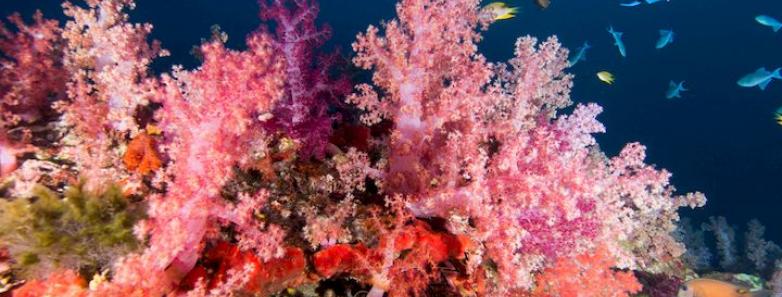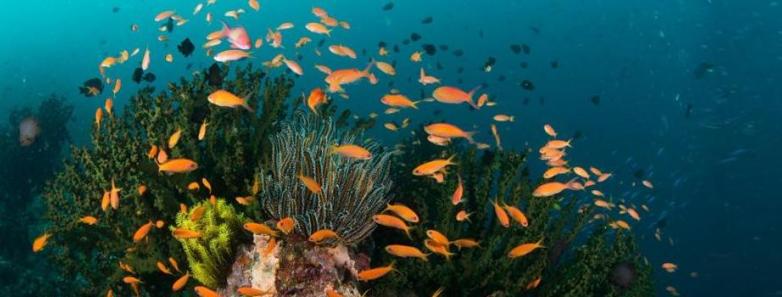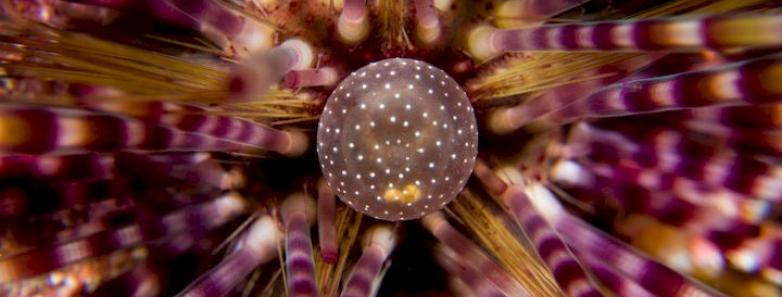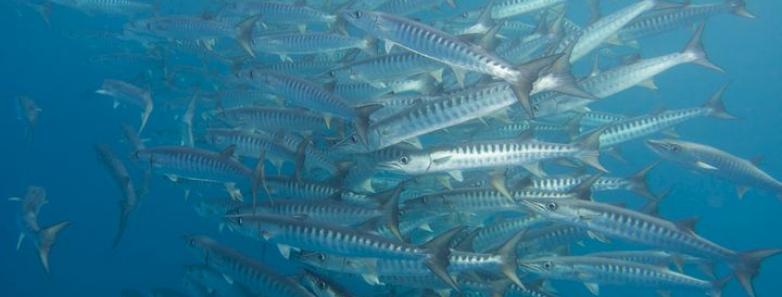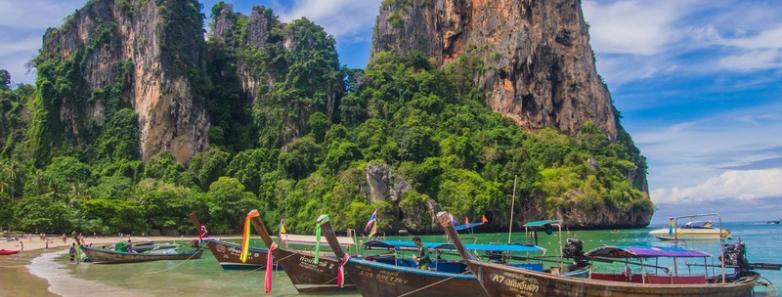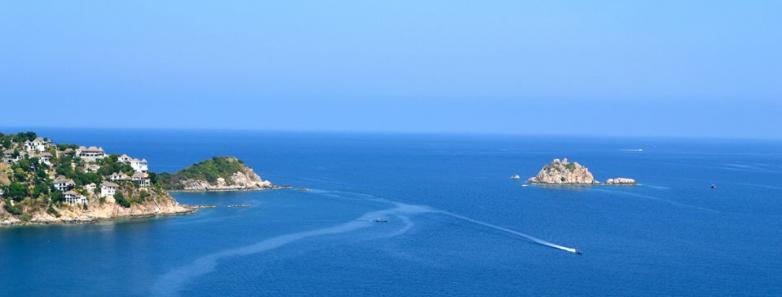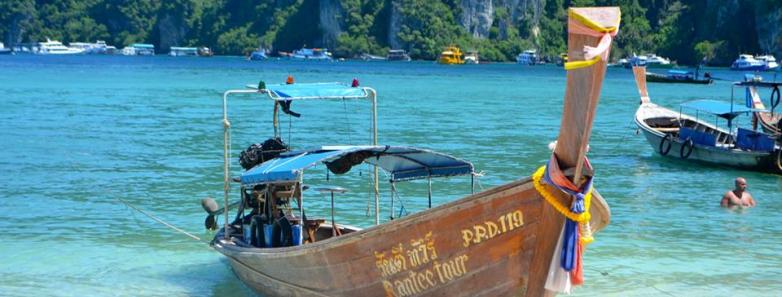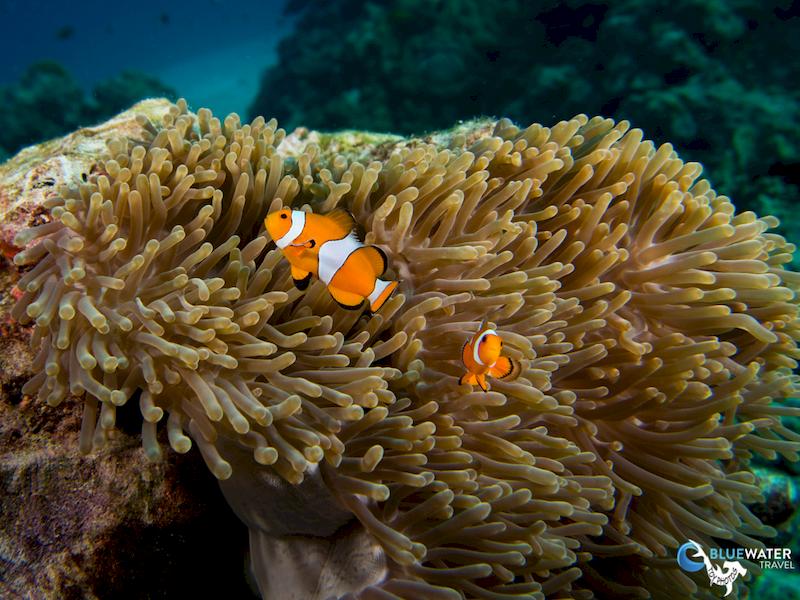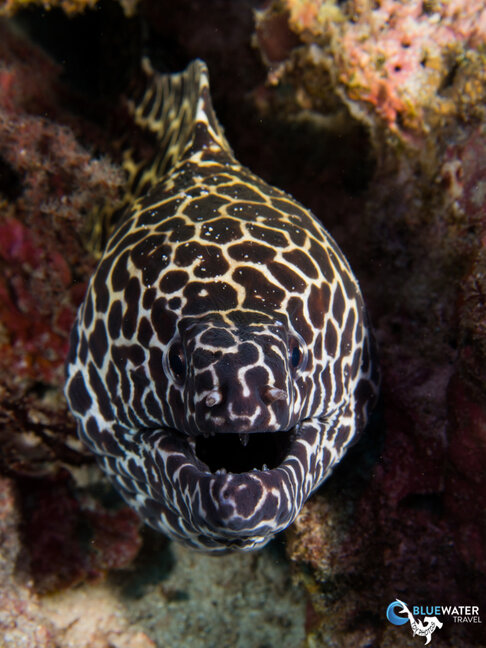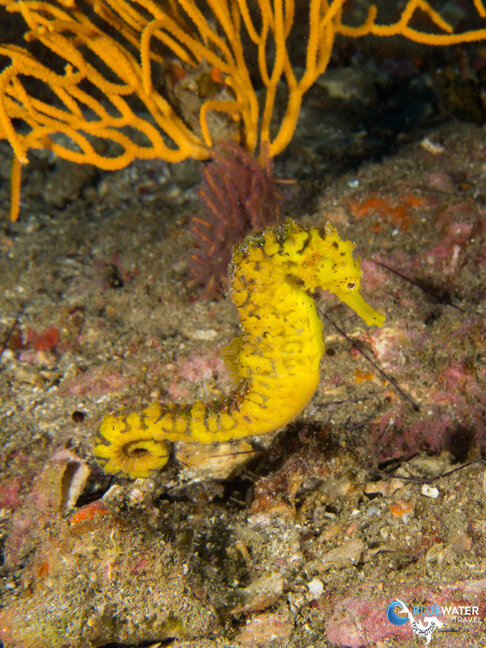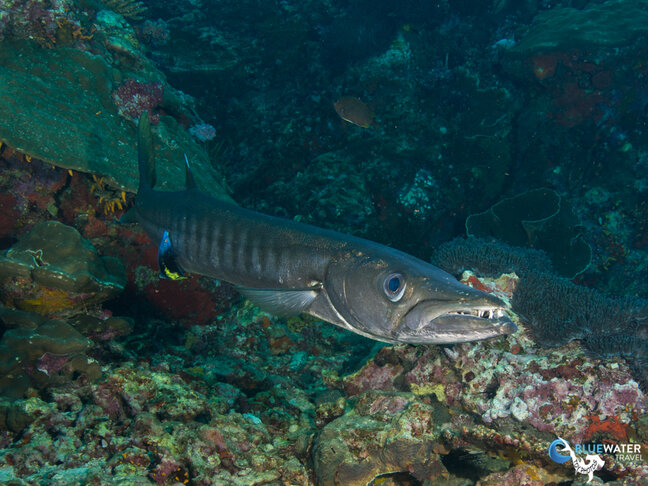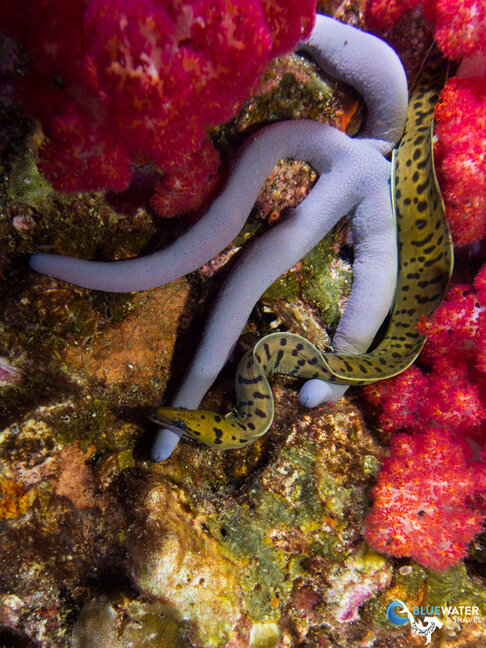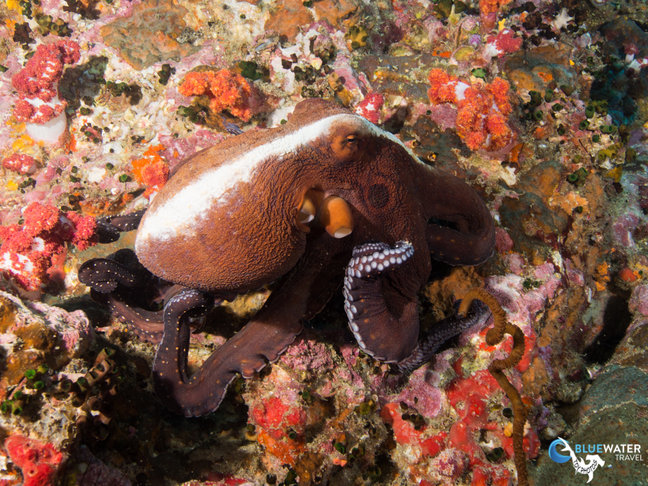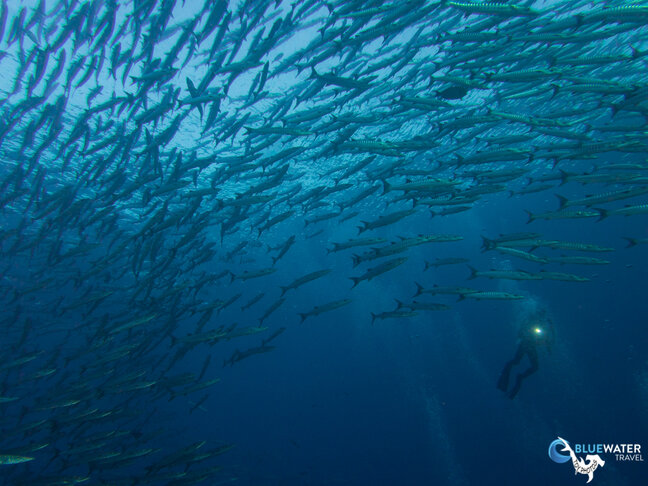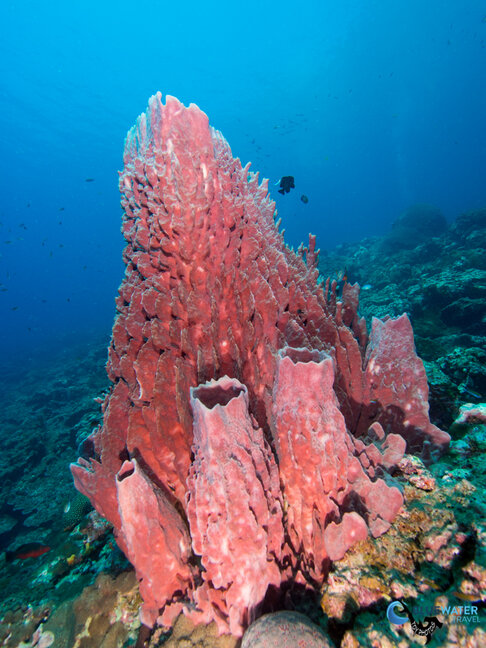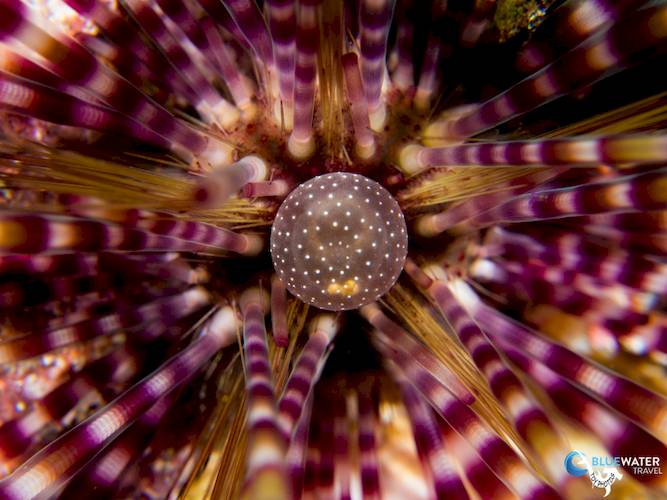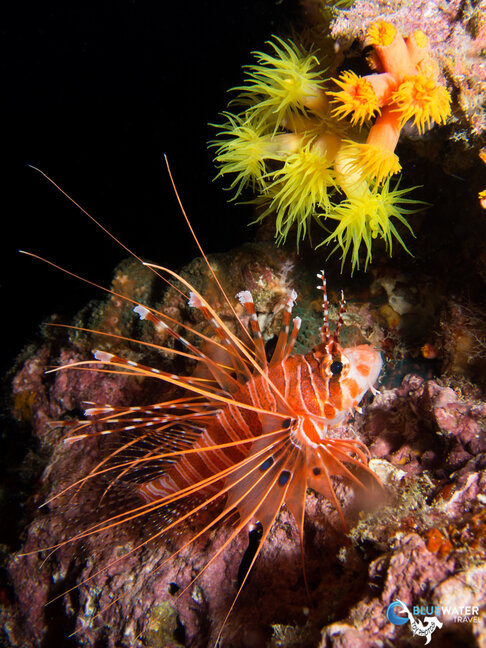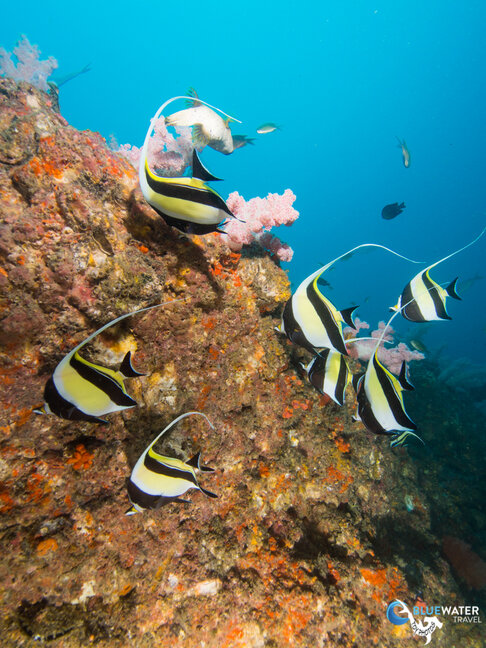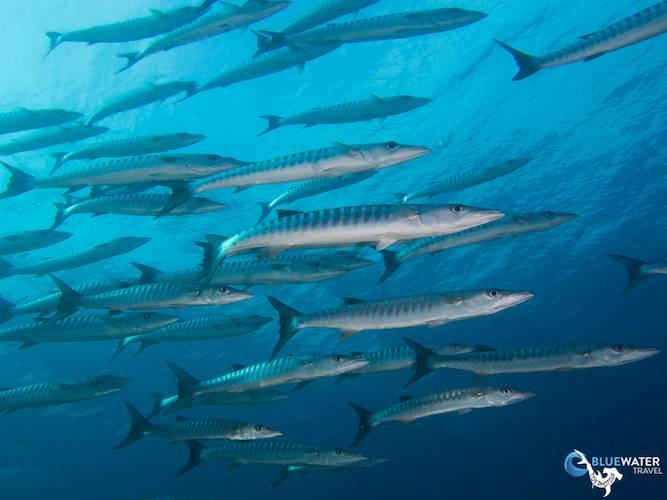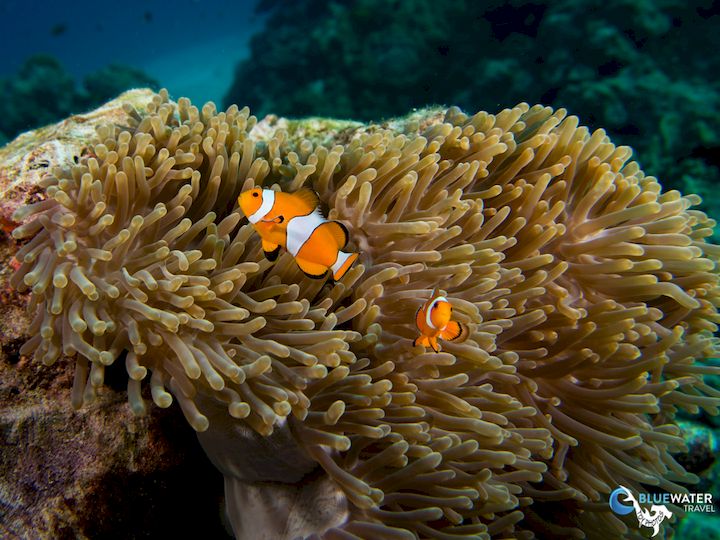Scuba Diving in Thailand
Thailand diving highlights
Hosting divers in both the Andaman Sea and the Gulf of Thailand from over 1200 miles of coastline, this scuba destination is a great fit for divers of any level. Scuba diving in Thailand is popular due to the opportunity to dive with whale sharks and manta rays. You can see many pelagics and smaller fish and critters. Many dive sites have beautiful hard and soft coral and abundant marine life.
Thailand dive schools have a great reputation, which is why it is also known as one of the best destinations to learn scuba diving or develop new skills as a certified diver. A combination of big and small marine life, wrecks and dive sites for a variety of levels makes Thailand one of the best scuba diving destinations in Southeast Asia.
Thailand's Best Diving Spots
Pick a destination or scroll down to read the entire list:
- 1. Koh Tao - Great reputation for dive schools
- 2. Koh Phi Phi - Many dive sites for spotting leopard sharks
- 3. Koh Lipe - Most beautiful soft corals
- 4. Surin Islands - Unique species and diverse hard and soft coral
- 5. Similan Islands - Great for spotting manta rays and whale sharks
- 6. Phuket - Variety of options for different tastes
- 7. Pattaya - Excellent wreck dives
- 8. Koh Samui - Calm waters, good visibility, and good to see whale sharks
Can't wait to start planning your trip to Thailand? Get in touch with us to help you plan your trip!
Looking for a Liveaboard in Thailand?
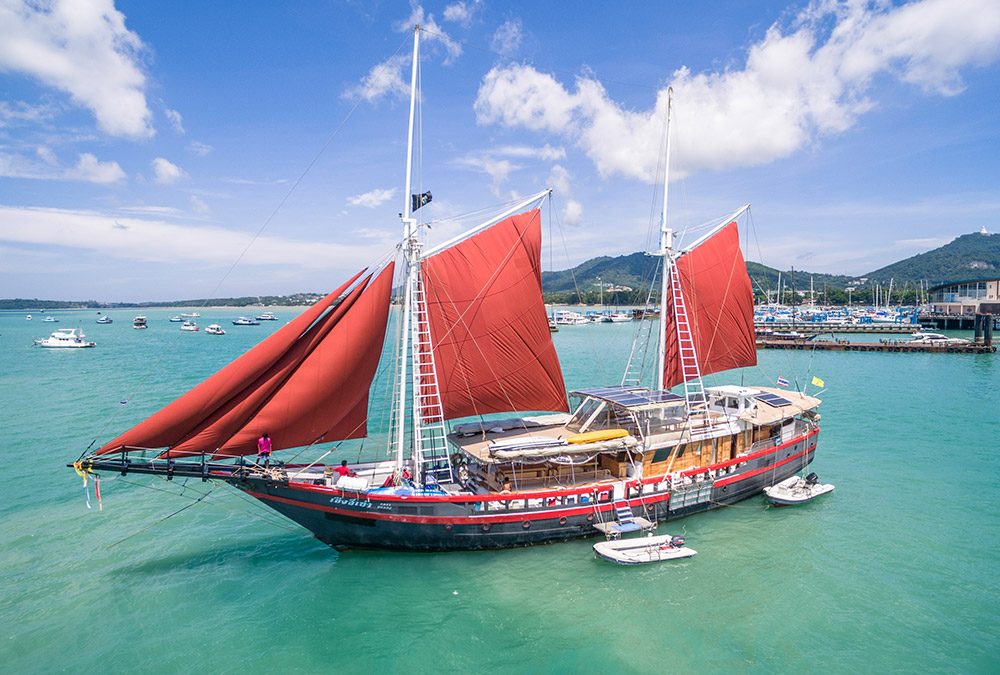
Master Liveaboards' The Phinisi is a 34-meter, custom-built diving liveaboard yacht designed in the traditional Indonesian gaff-rigged Phinisi style, complete with 7 sails. It offers liveaboard dive adventures in the stunning waters of Thailand and Myanmar, comfortably accommodating 18 divers. Guests can relax on the spacious dive deck or enjoy meals in the shaded outdoor dining area while taking in breathtaking views. With delicious Thai dishes prepared from fresh, local ingredients and a dedicated crew attending to every need, your diving holiday promises to be both enjoyable and unforgettable.
1. Koh Tao
Head to the Gulf of Thailand to visit the small island of Koh Tao - the perfect place to try scuba diving for the first time, get your dive certification, or hone your skills underwater. While neighboring Koh Phangan is infamous for its full moon parties and Koh Samui has long been a favorite of backpackers and luxury travelers, Koh Tao is the hotspot for scuba diving in the region. This small island is crowded with backpackers and offers many accommodation options and a great food scene. To get to Koh Tao, you can fly into Koh Samui's International Airport (USM) and then take a taxi or shuttle to a ferry or fast boat departing from one of the piers, all of which can be arranged upon landing at Samui's airport with little hassle.
Great reputation for dive schools
People flock to Koh Tao to begin their underwater journeys and get scuba certified, earning the island a reputation for its great dive schools. You'll find some of the cheapest scuba courses in the world in Koh Tao, with options to get certified by any of the major organizations, including RAID, SSI, and PADI. With easy conditions, numerous dive sites, and tons of accommodation options, it's clear why Koh Tao is so popular for those looking to learn to scuba dive or continue their dive education. Diving in Koh Tao is done by boat to various dive sites surrounding the island. Expect decent visibility (depending on the season) and encounters with colorful reef fish, turtles, barracuda, and macro critters such as nudibranchs, shrimps, and crabs. Lucky divers may even meet a whale shark! Due to the huge, crowded boats used by local dive operators, you can also expect to see plenty of people underwater, which some divers prefer to avoid.
You may also want to check out our list of the Best Liveaboard Destinations for Beginner Scuba Divers.
2. Koh Phi Phi
Visit Thailand's west coast white-sand paradise, the Koh Phi Phi Islands, to experience land-based diving in the Andaman Sea. Shortly after the movie "The Beach" was released in 2000, Koh Phi Phi Don soared in popularity among backpackers and gained a reputation as a party island. However, the island boasts a variety of accommodation options from budget to luxury and attracts all types of tourists seeking picture-perfect white-sand beaches and clear blue waters. Phi Phi is mostly dived from land-based operations, however, some liveaboards offer short itineraries around the islands.
Many dive sites for spotting leopard sharks
Expect to encounter leopard sharks as you explore the dive sites surrounding the Phi Phi Islands, and if you're lucky, you could also see whale sharks and manta rays. Turtles, barracuda, reef sharks, and moray eels are common sightings. Look for macro life on the reefs, where seahorses camouflage and peacock mantis shrimp dart in and out of crevices. Travel by boat to various Phi Phi dive sites boasting beautiful corals and fascinating rock formations. Conditions are suitable for divers of all experience levels, so it's a great place to get your scuba certification or explore deeper dive sites if you're more experienced.
3. Koh Lipe
Travel further south on Thailand's west coast to the small, idyllic island of Koh Lipe to escape the crowds and explore less frequented dive sites. Stay at a budget hostel, a luxury pool villa, or any of a range of accommodation options. Embrace the barefoot lifestyle on picturesque white sand beaches straight from a postcard and dive into the protected dive sites surrounding the island.
Most beautiful soft corals
With fewer visitors than Koh Phi Phi and Phuket, the coral reefs around Koh Lipe are better preserved, which makes it a fantastic diving destination. Dive sites around Koh Lipe boast some of Asia's most beautiful soft corals. Koh Lipe is part of the Tarutao National Marine Park, home to many dive sites suitable for divers of all experience levels. Expect to see various tropical fish species, turtles, and dolphins. If you're really lucky, you could even see dugongs and sperm whales! Besides amazing marine life, it also has nice pinnacles and rock formations. Boat diving from land-based operators is the norm in Koh Lipe, and dive sites are reachable within 20-60 minutes. Some liveaboards offer itineraries that include Koh Lipe.
For another great whale destination, check out diving in the Dominican Republic.
4. Surin Islands
Embark on a liveaboard to the Surin Islands, a remote region in the Andaman Sea that is protected by the UNESCO Environmental Program. Choose from a range of liveaboards, from low-budget to ultra-luxurious, with most itineraries lasting between four and seven nights.
Unique species and diverse hard and soft coral
The Surin Islands' dive sites boast amazing hard coral diversity and bountiful soft coral and are rich in marine life. The remote islands are not as popular among tourists, so you can find some fish species here that you cannot see in other dive destinations in Thailand. You might spot bumphead parrotfish, Napoleon wrasse, tomato anemonefish, yellow-masked angelfish, and barramundi. The Surin Islands can be explored by dive liveaboards that mostly run from October to early May. The Mu Ko Surin Marine National Park is closed to divers for the rest of the year.
New to liveaboards? Let's help you get started with our Guide to Liveaboard Diving.
5. Similan Islands
Dive into Thailand's most renowned dive sites around the Similan Islands in the Andaman Sea. Visit the famed Richelieu Rock, a dive site on our list of Top 20 Dive Sites in the World. Join a liveaboard out of Phuket to explore the region on a four to seven-night itinerary.
Great for spotting manta rays and whale sharks
A dive liveaboard is the best way to get the most out of Similan Islands diving. Abundant marine life, big pelagics, soft and hard coral, easy diving conditions, warm waters, and relatively good visibility are reasons many scuba divers are fond of this destination. There are also plenty of macro subjects, but most divers visit the islands to look for manta rays and whale sharks. Moreover, you can see a number of shark species when scuba diving in the Similan Islands.
Interested in diving in the Similan Islands? You can read more about the destination from our Similan Islands Dive Travel Guide or Similan Islands Liveaboards page.
6. Phuket
Diving in Phuket gives scuba divers many options. You can find some secluded luxurious dive resorts or budget-friendly accommodations, make some day trips to the local reefs, or hop on a liveaboard and let local Thai divers show you some of the best dive sites in Thailand.
Variety of options for different tastes
Phuket has great sites for experienced divers and options for total beginners to start their diving journey. When diving in Phuket, you can find some great deep drop-offs, pinnacles covered with coral, some caverns and caves, and even some wrecks. The marine life around Phuket ranges from big animals to small creatures. You can meet manta rays, whale sharks, and leopard sharks, but also anemone fish, harlequin shrimp, and ghost ornate pipefish to name a few.
7. Pattaya
Pattaya is popular with Bangkok residents due to its seaside location, a mere two-hour drive from Thailand's biggest city. Don't mistake Pattaya for a quiet seaside town; it's a large city with pros and cons. The biggest 'pro' is that there is scuba diving in the area, and if you can't make it to the more popular dive regions or just want to sneak in a couple of days of diving on a short trip to Thailand, Pattaya is a convenient option.
Excellent Wreck Dives
Scuba diving in Pattaya is known for its excellent wreck dives and nice coral dive sites. One of the most famous coral dive sites is at Koh Man Wichai, where the coral resembles a giant hand and thus has been named as the "fingers". While diving around the beautiful corals, you can spot pufferfish, stingrays, angelfish, and many more. The Pattaya wrecks are also covered with reefs, where you can spot rays, barracudas, batfish, and even sharks. The wrecks are most suitable for advanced divers, as they lay around 100ft (30m) or more.
8. Koh Samui
Like nearby Koh Tao and Koh Phangan, Koh Samui is a popular holiday destination and more crowded than some other locations in Thailand. You'll find a huge range of accommodation options, from hostels to the Ritz-Carlton, food options from street markets to fine dining, and plenty of activities. Scuba diving is done by boats making day trips to the beautiful dive sites around Koh Samui and Koh Tao.
Calm Waters, Good Visibility, and Good to see Whale Sharks
Some of the best dive sites in Thailand, like Sail Rock, are very close to Koh Samui. A highlight of diving around Koh Samui is the chance to spot whale sharks. You can also see many barracudas, turtles, jackfish, and various nudibranchs and shrimp for macro lovers. Additionally, the diving conditions in the Gulf of Thailand are good throughout the year, with calm waters and generally good visibility.
Top Dive Sites in Thailand
Thailand's diving is varied between regions, but if you're looking for the top dive sites on both coasts of Thailand, we've got you covered! Here are our picks for the top dive sites in Thailand:
Hin Daeng & Hin Muang
Many scuba divers will say these are their favorite dive sites. They offer great wall dives and caverns, as well as big pelagics and lots of other beautiful marine life. You may even spot manta rays and whale sharks here. Colorful soft corals are all around, and you can see many schools of fish. Be aware that the currents can be strong; thus, it is recommended for more advanced divers. Both of the dive sites are located outside of the Similan Islands.
Shark Point
Explore the Shark Point dive site near Phi Phi and close to Anemone Reef to seek the leopard sharks often seen in the area. Expect underwater pinnacles adorned with soft and hard coral, anemones, and gorgeous sea fans. Look for camouflaged scorpionfish, cute pufferfish, moray eels, and macro life, including shrimp, crabs, and nudibranchs. Dive operators in Phuket, Phi Phi, and Railay Beach make day trips to Shark Point and Anemone Reef, and liveaboards include the sites on some southern itineraries.
Anemone Reef
As the name says, you can expect to dive past beautiful blue and green-colored anemones. As part of a marine sanctuary, Anemone Reefs' marine life is very colorful. The site itself lies near Shark Point, which is why you can encounter reef sharks and leopard sharks at the dive site. Besides the sharks, you can spot some turtles, giant moray eels, lionfish, and even some seahorses, nudibranchs, and porcelain crabs for macro lovers. Along the anemones, you can see some beautiful soft pink and purple corals.
Check out our guide to diving Alor's Anemone Valley.
Richelieu Rock
The dive site is located between Surin & Similan Islands and is the best place to see schools of barracudas, many tropical fish, whale sharks, and manta rays. Because of nutrient full planktons, there is a high chance to scuba dive with whale sharks. The dive site is a horseshoe-shaped rock covered with soft corals, anemones, sea fans, and sponges. The dive spot attracts lots of marine life, and you may see cuttlefish, seahorses, and pipefish, just to name a few.
Chumphon Pinnacle
One of the most popular dive sites in Koh Tao, this huge pinnacle is covered with pink anemones, where pink anemonefish come around, as well as some scorpionfish, moray eels, crabs, and shrimp. Besides them, along the pinnacle, you can see some barracuda, bannerfish, mackerels, trevally, big-eyed jacks, and many more. Even whale sharks can make an appearance there.
Sail Rock
Another popular dive site in Koh Tao with a rock wall drop. Being further from the main island and away from the masses, it attracts abundant marine life. Batfish, soldierfish, crabs, giant groupers, giant moray eels, blue spotted trout, and nudibranchs are just a few examples of marine life you might see. What is special about this dive site is that you can actually dive inside a rock! There is an interesting swim-through called the chimney, which is very fun to dive, but it is more suitable for experienced divers, who have good buoyancy control.
HTMS Sattakut wreck
Laying at a depth of 100ft (30m), this wreck is surrounded by colorful marine life and is considered one of Thailand's best wrecks. It has three canons, cabins, and rooms to explore and to see its many resident fish. You can spot groupers, snappers, sweetlips, barracudas, blennies, moray eels, butterflyfish, and more.
Diving Information
Intro to Thailand
The Southeast Asian country, which has a tropical climate and warm waters, is known for its beautiful white-sand beaches, stunning temples, rich culture, and delicious food. It is not hard to guess why many people are attracted to visit Thailand. Most of the best scuba diving sites are in the southeast of Thailand, in the Andaman Sea. On the east coast, on the Gulf of Thailand, lies Koh Tao, one of the most popular destinations for dive certifications.
All around Thailand, you can find diverse marine life and beautiful corals. The destination offers many opportunities for scuba divers to dive at beautiful reefs, explore wrecks, deep drop-offs, caverns, pinnacles, walls, and tunnels. Besides scuba diving, Thailand offers plenty of topside activities. Some of the islands offer great nightlife, while some others are quieter and great for relaxing.
Thailand Marine Life
In general, the Andaman Sea boasts a larger variety of fish species and coral. As to what you can expect to see - the coastline and islands stretch over a large distance so it greatly depends on where you choose to dive. Manta rays, whale sharks, black/white tips, and turtles are just a few of the "big things" to expect. Not only is it a great destination to see big fish, but Thailand also has many macro photography subjects.
Here is a list of the marine animals you are likely to see when diving Thailand's best dive spots:
- Whale Shark
- Manta Ray
- Leopard Shark
- Whitetip Shark
- Blacktip Shark
- Spotted Eagle Ray
- Bluespotted Ribbontail Ray
- Pufferfish
- Trevally
- Trumpetfish
- Butterflyfish
- Triggerfish
- Lionfish
- Moray Eel
- Angelfish
- Boxfish
- Turtles
- Barracudas
- Ghost Pipefish
- Seahorses
Diving Conditions
- Water Temperatures: 81-84 F / 27-30 C
- Visibility: Varies from 16-131 ft (5-40m).
- Depth Range: 16-131 ft (5-40 m)
Travel Information
How to Get There
Thailand currently has six international airports, with Suvarnabhumi International Airport in Bangkok being the main gateway to the country. It is easy to get anywhere from Bangkok, with varied transportation options, including domestic flights, trains, buses, and boats. You can also fly internationally into the airports in Krabi (great for accessing Railay Beach), Phuket (where you'll head to Phi Phi or on a liveaboard to the Similans), or Koh Samui (a 1.5-hour catamaran or 2.5-hour ferry ride to Koh Tao).
Looking for another hot dive destination in Southeast Asia? Read about scuba diving in Indonesia.
How to Dive Thailand
Liveaboards are available to explore the Andaman Sea and Similan Islands and reach dive sites you otherwise can't reach. Thus, liveaboard diving would be the best option for getting the most out of diving in Thailand. There are also dive resorts available around Thailand and plenty of standalone dive operators. Phuket, Phi Phi Islands, and Khao Lak are the best resort destinations. Don't expect local dive guides; unlike Indonesia and the Philippines, Thailand's dive scene is often run by expats, with locals working as support staff and boat crew.
Best Time to Dive
Within the Gulf of Thailand, diving is available almost year-round. November is the beginning of the monsoon season in which visibility drops and heavy rainstorms can occur, but by the end of December things typically have gone back to normal. On the Andaman side, dive times are more limited. Some areas are only available to dive parts of the year (like the Similans and Koh Lanta). In general, October to April is the best time to dive into the Andaman Sea.
Topside & Non-Diving Activities
You can try to "island-hop" to different destinations by comparing their offerings. Every island has its own personality, so certain islands would fit best depending on what you are looking for. Looking for a night out in the town? Koh Phi Phi on the Andaman side or Koh Tao in the gulf would be a good start. Prefer a relaxing evening instead? The Andamans, Koh Lanta, or Koh Samui in the Gulf could be better alternatives.
Head inland to Chiang Mai and/or Chiang Rai to experience Northern Thailand's unique landscapes, culture, and food. You won't find any diving in Northern Thailand, but you can embark on some excellent nature tours, see some different temples, and feel a different vibe than you'll find on the islands. Be sure to try Khao Soi, an incredibly delicious Northern dish featuring noodles, chicken, and toppings in a flavorful curry broth.
Thailand is known for its beautiful beaches and some impressive temples. Don't forget to visit the famous Grand Palace or Temple of the Emerald Buddha. Some of the other things to do are to see the Muay Thai boxing match, visit a floating market, go hiking, or discover their beautiful nature. Moreover, get all your tension out with a proper Thai massage. In case you have never tried a Thai massage, then just a heads up, don't expect it to be relaxing, but for sure, it will make you feel much better afterward!
Wherever you end up in Thailand, the rich culture and sensational food scene will not disappoint. Visit bustling night markets to try a variety of street food and purchase souvenirs. Please be wary of any attractions purporting to be animal sanctuaries, as many do not operate as true sanctuaries and use the animals for entertainment to interact directly with visitors. There are currently no accredited animal sanctuaries in Thailand.
Liveaboard Availability & Booking
Please contact us for the latest availability of the following boats: Diva Andaman, Similan Explorer, MV Hallelujah, Dolphin Queen, Deep Andaman Queen, MV Giamani, DiveRACE, MV Oktavia, and MV Pawara.
Other Useful Information
Practical Information
- Currency: Thai Baht (THB)
- Language: Thai is the national and official language of Thailand
- Main Airport Code: BKK
- Time Zone: UTC+7
- Electricity: The standard voltage is 220 V, and the frequency is 50 Hz.
- Vaccines: Please check the CDC website for updated information on vaccines, health concerns, etc. It is recommended that you are up to date with Typhoid, Tetanus/Diphtheria, Hepatitis, and Polio for any trip to the tropics.
- Visa: U.S. citizens carrying a tourist passport and in possession of an onward or return airline ticket do not require a visa to enter Thailand.
GOT QUESTIONS? READY TO BOOK?
Call us today at 310-915-6677 or email us info@bluewaterdivetravel.com
And let us book your dream vacation!
Scuba Gear
You can now buy all the best scuba gear with Bluewater! Check out our wide selection of top-rated dive equipment, including Tusa dive masks, Aqualung Titan regulators, Mares BCDs, and more!
Further Reading
Check out these useful resources from our sister websites, Bluewater Photo, and Underwater Photography Guide
Southeast Asia's Best Underwater Photography Destinations
Top 10 Macro Photography Destinations

